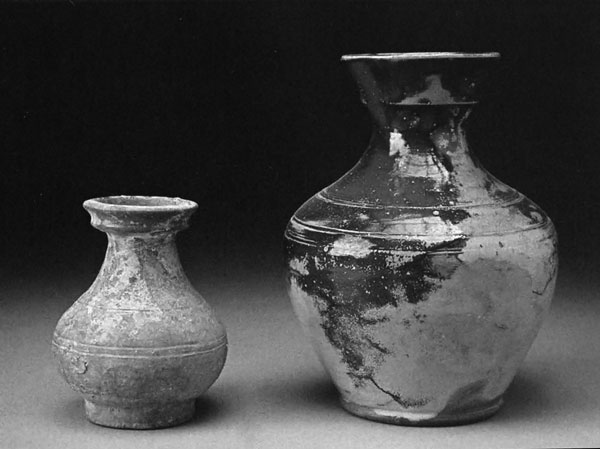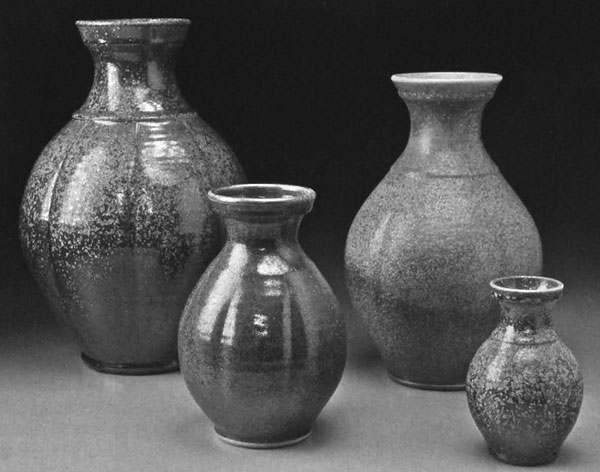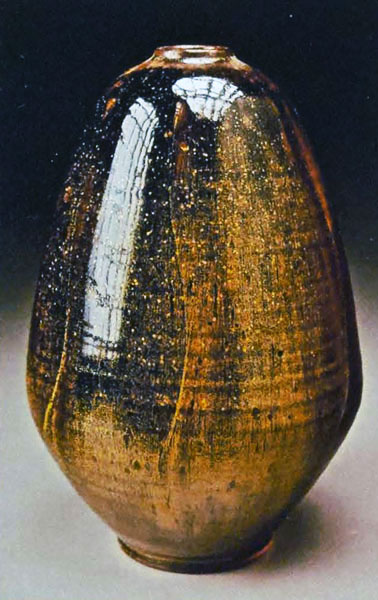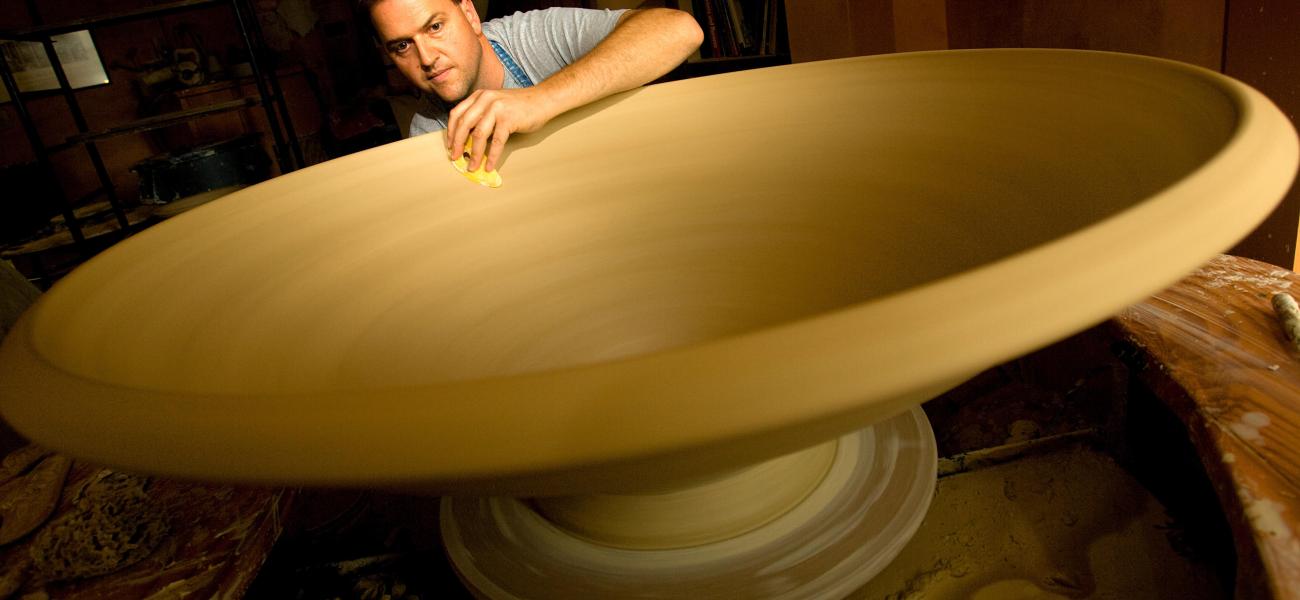Translating Tradition: The Pottery of Ben Owen III
Ben Owen III's studio and gallery are located on the same land in Seagrove, North Carolina, where his grandfather opened Old Plank Road Pottery in 1959 following a long career at Jugtown Pottery, where he had worked for more than three decades. At Old Plank Road Pottery, Ben Senior crafted his own unique mixture of utilitarian "dirt dishes" and artware pottery inspired by simple Asian forms and vibrant glazes, until illness forced his retirement in 1972.
In 1923, Ben Owen, Sr., then eighteen, met Jacques and Juliana Busbee, founders of Jugtown Pottery in Steeds, North Carolina. After trying for some time with limited success to get their pottery going using local potters, Jacques and Juliana turned to younger potters who had the skills but were not so fixed on which forms and glazes they would use. In Ben Owen, they found what they were looking for. Unlike his father, Rufus, young Ben was open to Jacques Busbee's ideas for "translations." This was the term coined by Jacques Busbee and Ben, Sr. to describe the wares they created a hybrid of early American utilitarian and Asian decorative forms.
At Jugtown, the Busbees and Ben Owen, Sr. began to design and make open forms based on early Chinese pottery from the Han, Song, Tang, and Jin dynasties. The pottery was glazed in vivid colors, and the glazes were given distinctive names, including Dogwood White, Mirror Black, Chinese blue, Frog Skin, and Tobacco Spit. These glazes stood in stark contrast to the natural brown and neutral finishes used in the Seagrove area for generations. In Seagrove, glazes had been considered merely waterproofing agents, and little thought was given to the aesthetic of the finished pieces. A painter, Jacques Busbee was an active participant in the design of pottery forms and glazes at Jugtown. The new glazes were often applied using a brush rather than the traditional methods of dipping or pouring the glaze onto the vessels. This com bination of new colors and a distinct glaze application brought new dimension to the pieces.
Jacques Busbee purposefully kept Jugtown as a cottage industry, focusing not on how much pottery was produced, but rather on creating high-quality pieces, made individually. An old Jug town marketing brochure sums up his philosophy in this way: "It is not how much is turned in a day's work, but how beautifully."
Ben Owen III credits his grandfather's adaptability and willingness to listen to outside influences as being as necessary as his talent in creating his innovative body of work. Ben Sr. was eager to learn and integrate into his work new shapes and glaze colors. He successfully made the move to art pottery while bringing a renewed respect to his handcrafted utilitarian wares, which were created with a new eye for detail. Rims were finished, distinctive handles were added, and the theory of Ben "less is more" was advanced.
Ben Sr. took a risk in breaking not only with Owen family tradition but also with the long held beliefs of his community. Ben relates: "Many locals ridiculed [grandfather] for breaking the time-honored old traditions, and for taking up with the newcomers the 'artsy' Busbees, but time revealed he was on the right side of history."
Other families in the Seagrove area who had been there for generations the Aumans, the McNeills, the Chriscos, the Lucks, the Cravens, the Coles, and the Teagues, just to name a few were also beginning to change their outlook and to transition toward art pottery during the early first half of the twentieth century. This change was due in part to politics and to shifts in the economy. Prohibition meant there was less demand for the utilitarian jugs most potters had looked upon as their mainstay in previous years. The industrial revolution had also brought competition from mass-produced metal and glass containers that many potters simply could not compete with, forcing many Seagrove area potteries to close. Then the emergence of art pottery in the 1920s opened a new market for those who were willing to adapt.
As the demand for art pottery escalated, the Seagrove area experienced terrific growth. Potters began to move beyond the basic jug to create wares with more symbolic, decorative uses. They were drawn to the region because it offered a natural abundance of clays needed to establish potteries, but, observes Ben, would go outside of the region for inspiration, bringing new ideas back to Seagrove and constantly building on the strong foundation of the community.
Under the tutelage of the Busbees, Ben Senior traveled to American museums and viewed private collections of Asian masterworks; he also amassed a library of new glaze colors, pottery shapes, and surface textures during his thirty-five years at Jugtown. He used this knowledge to open Old Plank Road Pottery in 1959.
For sixth-generation potter Ben Owen III, training on the potter's wheel started at a young age. He would spend time after school and on weekends with his grandfather, who always stressed the need for good form, weight, and balance. He remembers being told repeatedly how important a strong foundation and a good mindset are in creating a sound piece of pottery. The need to constantly hone his skills and to think of each pot as a sketch for the next one was also emphasized.
Ben acknowledges that his grandfather and his father, Ben Wade Owen, Jr., were great mentors, who encouraged him to pursue a formal study of his art. Ben attended Pfeiffer University and then East Carolina University, where he graduated with a Bachelor of Fine Arts degree. Before going to college, Ben had learned his craft the traditional way, working as an apprentice, first with his grandfather, from 1977 to 1983, and then with his father, from 1984 to 1987. Ben credits this mix of education with helping him to appreciate and value his family tradition, while allowing him to use it as a platform on which he could build new and complementary ideas.
It was during Ben's time at East Carolina University that he first began to explore family glazes and research how they reacted to different firing environments and methods. He explains that he began to question how the glazes could evolve: "Early in my career, I did not examine the origins or virtues of these family recipes. They were simply a means to an end. But just as my grandfather had reinvented himself and his work through outside influences, I was about to take my journey into the exploratory and theoretical university setting."
In conducting his research, Ben brought to bear his experience working in the family pottery. "One common color agent we investigated was copper," he explains. "When added to a glaze, various shades and intensities of green, and - with the right atmosphere - oxblood reds, appeared. Utilizing my prior experience working with copper to produce the Chinese blue, I tried similar mixes of materials, but fired them in different environments. For instance, a glaze my family had only fired in a wood kiln, I tweaked to account for what I knew to be true about gas firings and tried it in a gas reduction kiln. I did the same for the electric kiln, and so on."
The glazes that resulted from this experimentation were based on the Japanese Oribe style of copper glazes. In the gas and electric kilns, the finish was a darker green with opalescence, but when fired in a wood kiln with salt, the color would vary from a more vibrant blue-green to a bleached turquoise, depending on the position of the piece in the kiln. Slow cooling of the kiln would promote the formation of micro-crystals on the surface, due to the presence of tri-calcium phosphate from small amounts of bone ash in the glaze reacting with the copper and the wood ash from the kiln.
Working from recipes his grandfather had used, Ben employed modern technology to control the firing and cooling processes. He also carefully documented every variable as he experimented with gas and electric kilns, and he noted the different size and brick used in the smaller wood kiln at ECU. Through this intense research process, Ben "found a wide range of colors and textures that did not resemble the previous work in our family pottery." In this way, he made his own contribution to the Owen family glaze palette.
His development of these glazes taught Ben the value of research and experimentation on site: "The water source, the precise ingredients in the kiln bricks, the prevailing winds, the specific qualities of the fuel source, the firing skills of the assistants, are all variables that cannot be fully duplicated in an alternate location. There is no substitute for conducting your own research and development in your own studio."
Thus began a twenty-five-year journey
of constant search and discovery for Ben Owen III. He has continued his research, and his desire to advance the family legacy has never abated, despite the day-to-day pressure to keep shelves stocked in the family's retail business. According to Ben, "herein lies the downside of operating within the confines of tradition: expectations. But thankfully, the progressive character of our tradition has been revealed."
In 1995, with his family's encouragement, Ben went to Japan on a ceramics fellowship. Ben states, "Many of the principles I learned [there] fit like puzzle pieces into the body of previous knowledge I had acquired through my family's influence and my formal university training." Other aspects of working in Japan were exciting - extended firings for wood kilns, new clays, soaking at certain temperatures, and new cooling cycles. These he was eager to try out at home.

When he returned from the six-week study and informed his father that he intended to do a three-day wood firing, Ben says his father thought he was crazy. However, when the firing was completed, his father was amazed at the depth of color, the texture, and the ash effects the longer firing time had rendered. This was a moment of realization for Ben:
"I remember a grateful feeling of accomplishment and anticipation upon the realization that, as I opened the kiln door, I had passed through a portal to a whole new frontier of possibilities. I was standing on the cusp of what would become my mark on the family's traditional process. I could honor my past as I forged a new future, just as my grandfather had done 75 years before. Throughout history, each new generation has built upon the foundation laid by the old; I set out to take all that my family's heritage had afforded me and maximize my contribution to the cycle. I set out to patiently discover what time, experimentation, and perseverance could fully reveal."
Ben and his wife, LoriAnn, took over the operations of Ben Owen Pottery in 1998. They turned the building that had housed his grandfather's Old Plank Road Pottery into a museum dedicated to showcasing traditional forms that best represent the harmonious beauty achieved by matching simplicity of form with thoughtful, vivid color choices. This space has become a library for collectors and pottery enthusiasts, as well as a source of inspiration for Ben.
In 1999, Ben was preparing to build a multi-chambered wood kiln inspired by the kilns he had seen in Japan. He traveled to New Zealand and Australia to meet with potters who specialize in wood firing, including Robert Barron in Kardella, Australia. The following year Ben built his own multi-chambered kiln based on the Japanese Noborigama kiln. Dubbed "Pappagama," because Ben became a father for the first time during the year it was built, the kiln has four chambers. The first is shaped like a curved shell, similar to Japanese anagama kilns; the second and third chambers, connected to the rear of the first, are designed for easy walk-in access and for large-scale pieces. The final chamber is a smaller version of the preceding compartments.
His first firing in the new kiln brought unexpected results. The four-day firing rendered unintentional micro-crystal growth on the surface of a number of pots in each chamber. For Ben, this brought back memories of conversations in Japan about the need to soak the pottery near the peak of firing and to pay close attention to the cooling process. Inspired to continue experimenting with his own formulas for micro-crystalline glazes, Ben explains that "I found that spraying the glazes with a limited thickness and overlapping two or more colors would develop the best results for a layered surface similar to those early lengthened wood firings with the micro-crystals formations." The micro-crystalline glazes currently being produced by Ben are Teadust, Patina Green and, most recently, the Blue Stardust glaze.

Ben still looks from time to time to his grandfather's old work as a "reference library." He studies proportions or reviews how old glaze colors were mixed. He also reviews sketches of forms drawn by his grandfather and by Jacques Busbee. From this information, Ben creates something new; he adds his own twist so that people will know the work is a Ben Owen III piece. The resulting creation honors his family tradition while continuing to build on Ben's vision for its future.
Ben says a "hybrid of ideas" taken from the rich history of pottery in the Carolinas are sources of inspiration - in particular, the Cole family, the Catawba Valley potters, and the African potters of South Carolina's Edgefield District. The strongest influence on his work is Asian pottery, not just because of its forms and glazes, but also because of the cultural attitudes toward craft that permeate the work. Ben cites the Asian ideal as "intriguing to us as potters, because of the way the function of the pot is to be valued as much as the aesthetic. They see worth in something they use every day, versus our disposable society."
Today, Ben Owen III uses a mixture of seven local clays and some that are brought in from the surrounding states of Georgia and Tennessee. Ben digs many of the clays on property in the Seagrove area that he recently purchased in 2010. This land, locally called the Auman clay pit, was a common clay source for several potters in the area, including his grandfather. Ben has shared this source of clay with a local supplier.
Wood-firing is still a time-consuming process; from the firing to the soaking it can take up to four days to complete, depending on the glazes used. Ben likens the center of the kiln to the center, or sweet spot, of a tennis racket. The middle area of the kiln tends to reach the highest temperature and to maintain that heat longer. Therefore, pieces placed as close as possible to the kiln's center achieve the richest color. Pieces glazed in Chinese Blue - a base glaze of Prussian Blue with areas of copper red overlapping the base glaze - are placed in this position. Chinese Blue is one of the most desirable finishes for collectors because of the variation in hues and the fact that no two pieces look exactly alike. By applying this glaze in layers, leaving some areas with thinner applications than others, Ben achieves an end finish that is a balance of turquoise blue-green with patches of copper or oxblood red. Often two firings are required to attain the deep color contrast in this difficult color combination.
This is not the historical Chinese Blue glaze used at Jugtown, however. That recipe was created by Jacques Busbee, and after his death, his wife, Juliana, asked that it no longer be made. People kept asking for it, but it was lost. Ben, Sr. and his son Ben, Jr. worked at Old Plank Road Pottery and soon came up with their own recipe after repeated customer requests for the lost glaze; it was close to the original but had its own style. Today, Ben Owen III has reinterpreted the glaze. In the past, pieces with underdeveloped glazes were refired in the wood kiln. Ben has experimented with firing the blue-green pieces in a gas kiln, which creates a copper red and jade-green color mix with an iridescent sheen.
In the past ten years, Ben has accepted new challenges, working with designers to create custom installations for commercial and residential spaces. The result has been a demand for ever larger pieces. "While it's wonderful to have your work in such high demand," he says, "there is a practical consideration of how to effectively stack a kiln with big pots so that the glaze will heat consistently, delivering a pleasing finish throughout." Ben claims that this experience has trans formed his design work inside the studio more than an y other in recent years. In fact, he has begun incorporating large-scale pieces into his studio shows. To date, his largest installations have been five feet high.
Ben also speaks of the importance of artistic restraint, without which it would be impossible to maintain the clean lines and simplicity of color that give each pot the essential proportions that have become a hallmark of Ben Owen Pottery. There are more than one-hundred shapes in Ben Owen Ill's repertoire; this includes traditional pieces that have been made by the Owen family for years, along with new pieces Ben has added to "mix it up," offering loyal clients something new and continuing to push himself creatively. 
Seagrove continues to be a very distinctive place, where collectors can view a wide range of work made in one community. Ben Owen is emphatic in
his conviction that although some might see this concentration of pottery as a negative for the individual potter, the reverse is actually true. Individual potters can be successful if they create work of high quality, despite the large number of potters working in the area. People who lived and worked in the area for generations built Seagrove. Many of them came from pottery families that can trace their ancestral roots back to the Stoke-on-Trent region in England. However, in the past thirty to forty years, people from other areas have moved to Seagrove, bringing their gifts and talents to the region and building onto the community's solid foundation. The area has been transformed by a wider palette of pottery and a broader range of people making functional, decorative, and even sculptural work.
When asked how he would sum up his contribution to the Owen family legacy thus far, Ben thoughtfully replies:
"I am honored to continue a tradition of working in clay in our family. The shoes that my grandfather and father left for me have been big to wear, but with time and consistency, I have grown into them with wiggle room left to grow and add to the tradition. "
As his grandfather taught him, Ben Owen understands the importance of a good mindset in creating a fine piece of pottery. In approaching his work, Ben brings a philosophy formed by a myriad of beliefs: a keen sense and appreciation of the legacy inherent in the very name he carries, a sense of place, evidenced by his deep commitment to the Seagrove community, and most importantly for the future, a true sense of self, and the confidence and willingness to forge ahead and explore new means of expressing his own artistic vision.

